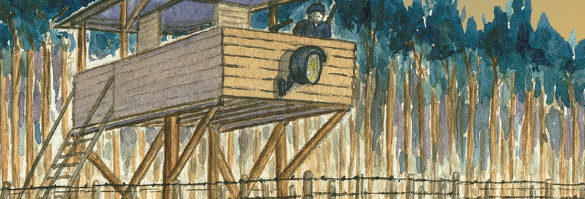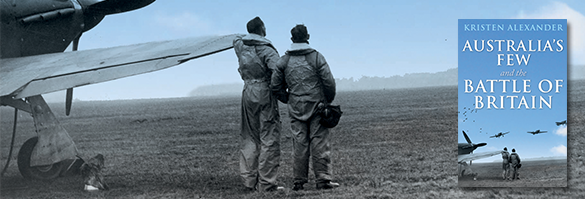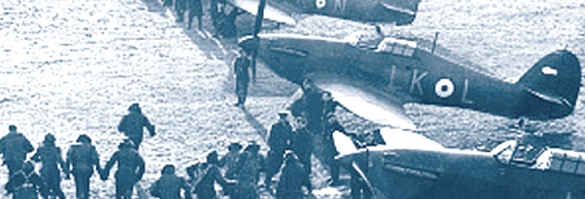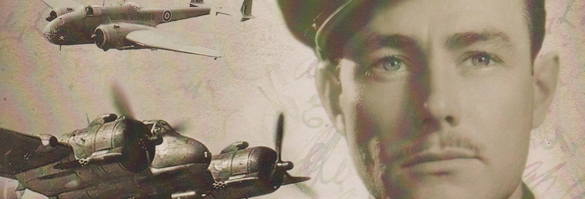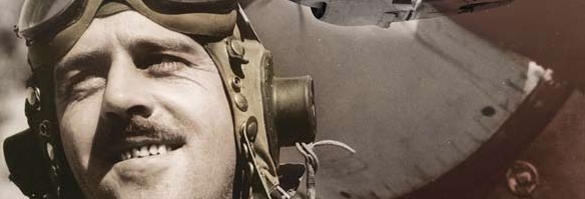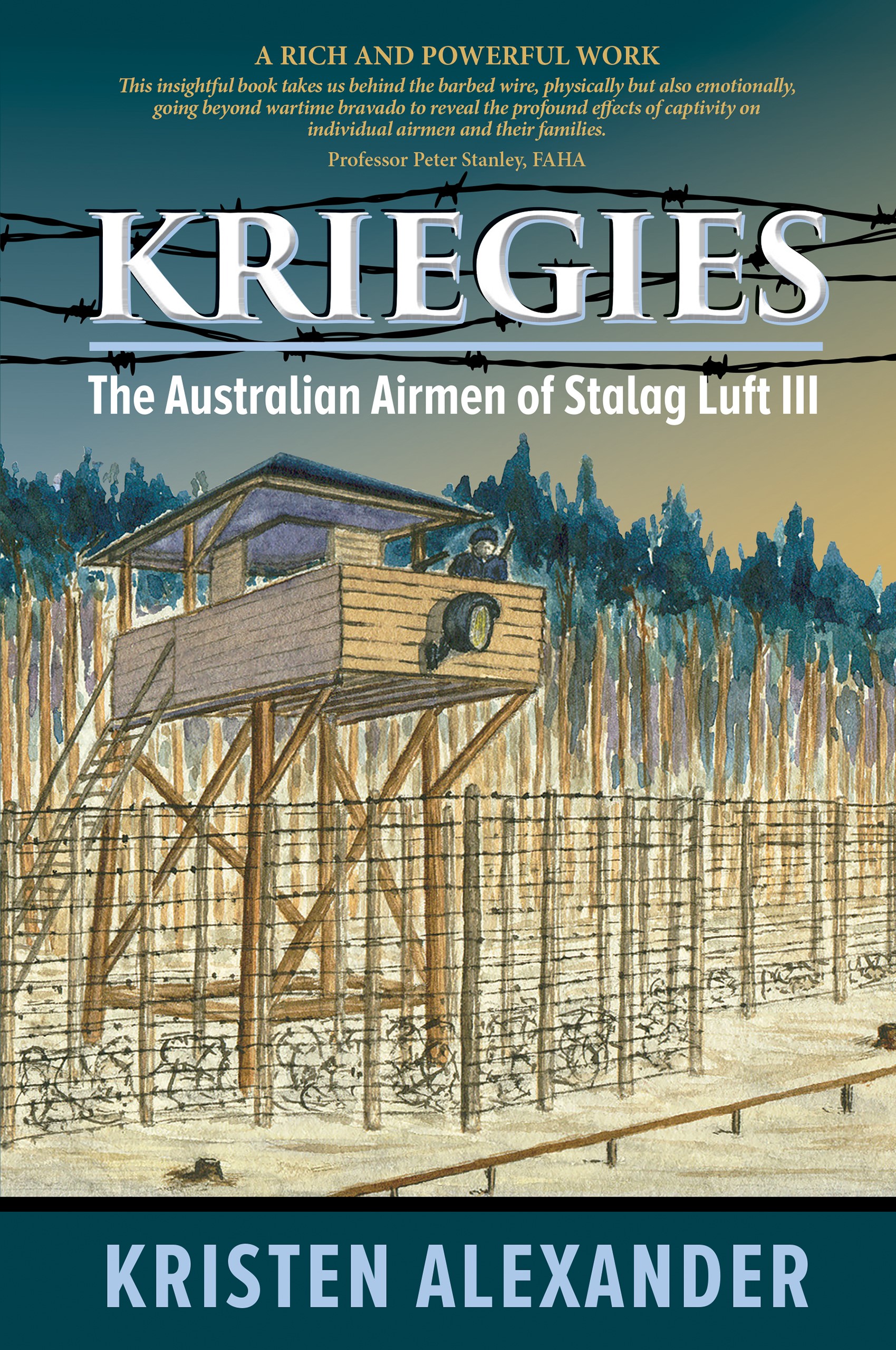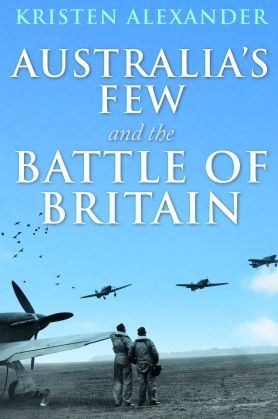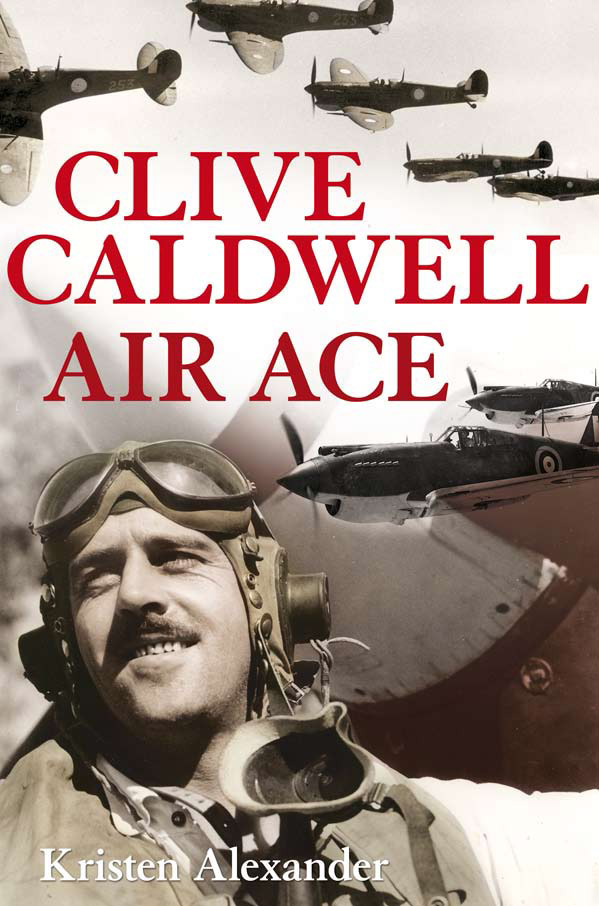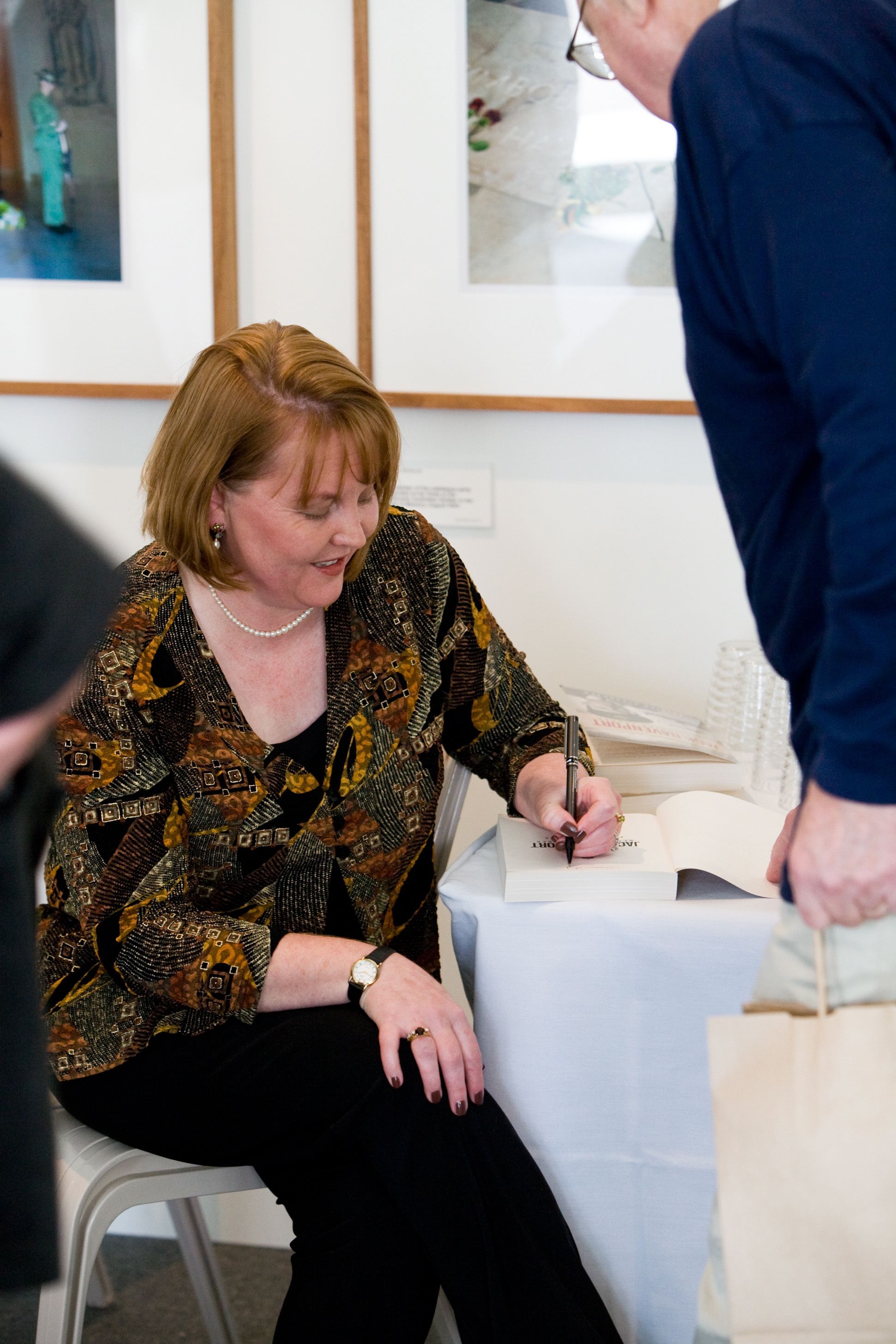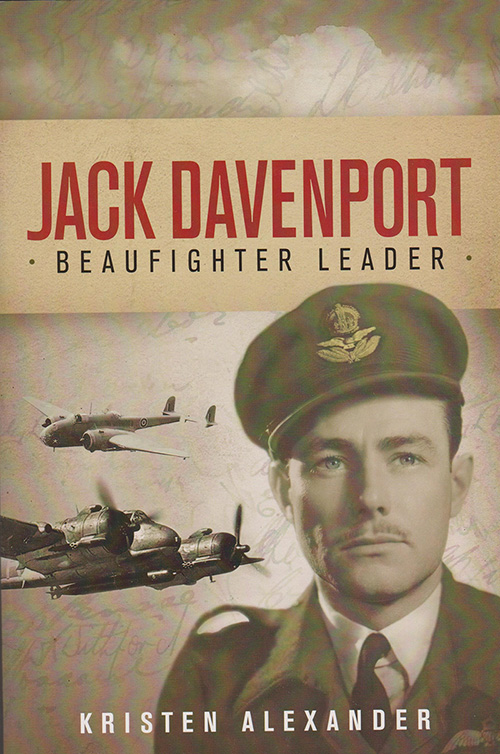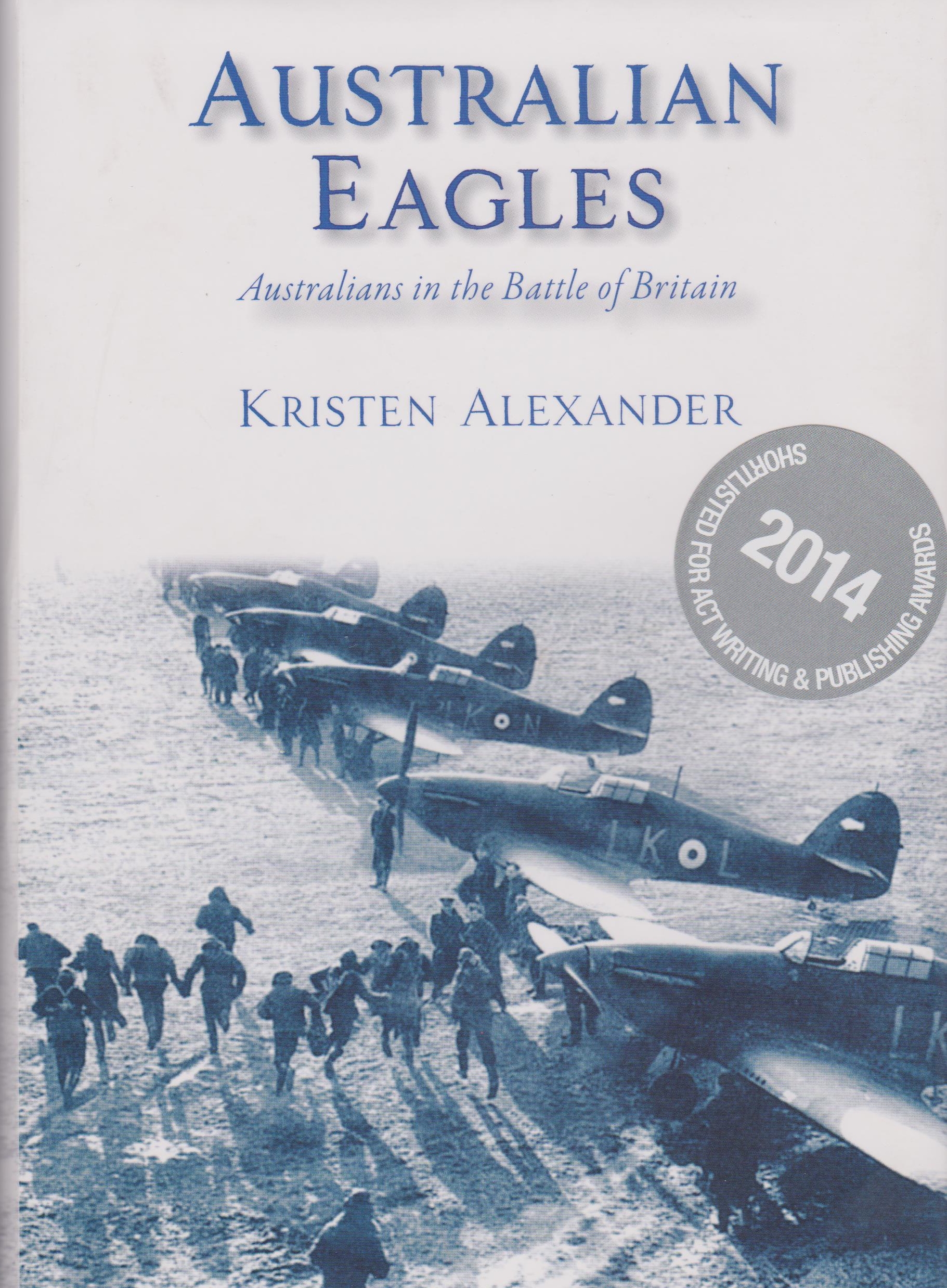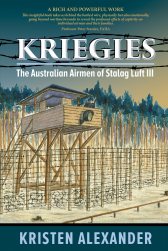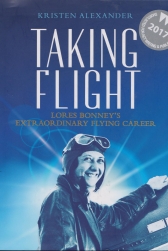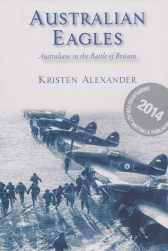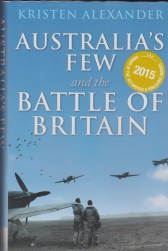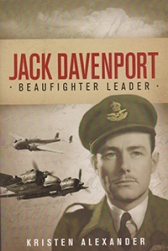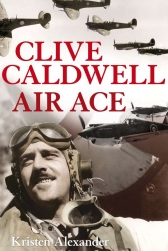Britain at War Magazine April 2016
Of the many books covering the subject that were published across the 75th anniversary of the battle of Britain this is certainly one of the most readable and engaging titles of the genre and Kristen Alexander, the author, is to be highly commended on this valuable addition to the literature dealing with the history of 1940.
In this volume, the author has not only used exacting academic rigour to compile what is a fascinating and worthy account of those Australians who participated in the Battle of Britain but she has also produced what is a most readable and engaging book.
To the reviewer, immersed in the hostory of 1940, the names of all the men Kristen has covered were more than familiar - although not their individual stories. In this respect she had the reviewer's rapt attention from page one and it is fair to say that this particular reviewer is sometimes hard to please when it comes to books on Battle of Britain related topics! Not so with 'Australia's Few'.
Looking in detail at the lives of just eight of Australia's national contribution to the Battle of Britain, Kristen Alexander is painstaking in giving an insight into the lives of each of the men she details, although it is harrowing to discover that only one of the eight came home at the end of the war. Nevertheless, throught assembling details gleaned from interviews, letters, private papers and official records the author has been able to construct the detail opf those seven young lives cut short in the Battle of Britain. Included in that detail, for example, are accounts of the battles in which they were engaged and in which they were often the victor but, ultimately, also the victim. The accounts of the actions in which they were involved are pacey, well-written, superbly researched and historically accurate in detail.
In her assembly of the facts, Kristen has also produced a book which is full of genuine empathy for her subjects and she has managed to construct a piece of work that stands not only as testament to the Australian 'Few' but also as a most useful reference source. Additionally, and importantly, it is also a truly excellent read. It is certainly a masterful piece of work and is one which is sure to be well-thumbed on this reviewer's book shelf over the coming years.
Nicely produced, and with a selection of evocative accompanying photographs, this book stands head and shoulders above many published in the Battle of Britain 'genre' across recent months and stands very firmly as this reviewer's favourite. Britain at War Magazine has no hesitation in recommending most highly this lovely book.
*****
Judges comments for Australia's Few and the Battle of Britain, winner of the nonfiction category of the 2015 ACT Writing and Publishing Award:
This is a very well-researched, well-documented, well-structured and well-written book. It looks at the role of the ’30 or so’ Australians who took part in the Battle of Britain through the lens of the lives of eight young fighter pilots. Each man’s story is brought to life using letters, diary entries, official correspondence, public records and family reminiscence. The eight stories are interwoven and, taken together, give readers a detailed perspective of how this historical battle unfolded. The use of family photos reinforces the ‘everyman’ nature of the pilots and brings home the real cost of war at many levels: individual, family, community and national. It is a book that can be read both for its engaging and sympathetic portrayal of the individual men and for its consideration of a pivotal time in the history of World War II. The writing is always fluid and engages the reader intimately with emotion and pathos. The need to convey accurate information never hinders the flow of the narrative. The author has an exceptional ability to set specific material, such as quotations from original documents, into a broader familial, social and political context, and in this way inform the reader at several levels at once. In addition to the incomparable writing style, this book stood out because of its very high production value, with excellent use of subheadings, maps, photographs, notes, bibliography, contents pages, author’s notes and index.
*****
XXXXX Five Star review on Amazon
5.0 out of 5 stars A terrific book.... highly recommended 14 July 2015
By Thomas Berekally - Published on Amazon.com
I was on Kristen's mailing list for this book right from the get go when she asked expressions of interest for orders of this title.
Her book arrived in the mail but I couldn't read it until my return from an overseas holiday. It more than fulfilled the triad of qualities I look for in a book on military aviation, namely a 'catchy' title, an easy to read writing style and a well researched subject matter.
I've read many books about the Battle of Britain both old and contemporary. I would rate this book as one of the best in my library collection and highly recommend it to all readers of military aviation history.
*****
ByBig Dud Published on Amazon.co.uk
A great read about 8 very brave Australian airman. You can feel the love and admiration that Kristen has for these men. They were a diverse group of pilots with varying skill sets and back grounds but they came together in The Battle of Britain.
Kristen explores the individuals and you get to know and start to understand their personalities and motivation as she weaves their story together in the context of the Battle of Britain.
They were 'ordinary' men rising to meet extraordinary demands in an extremely courageous manner; such is the manner of heroes.
Well done Kristen, as usual, wonderfully descriptive and empathetic towards the individuals who are the heroes of this book. this is a must read!
*****
Australian Defence Force Journal Issue No. 197, July-August 2015
Kristen Alexander’s latest title continues her exploration of her themes of the exploits of individual Australian pilots (Clive ‘Killer’ Caldwell and Jack Davenport) and also those who contributed to the fateful victory of the RAF in the Battle of Britain.
Epic battles must, of necessity, focus primarily on the bigger picture—the strategic balance and the forces contending, the rival commanders and their battle plans, the weaponry utilised by the opposing sides and, sometimes, almost as an afterthought, the individual combatants who fight, and, all too often, die in the subsequent struggle.
The author, in this extremely well-researched book, has skilfully reversed the focus without the reader losing this valuable larger perspective. The eight Australian pilots featured were carefully selected by the author to represent a wide cross-section of young pilots-to-be: state/private school education, Catholic/Protestant upbringing, RAAF/short service commission/RAF Volunteer Reserve-trained, married/about to marry/single during the struggle and finally, the ‘natural’ pilot/others about whom the training officers had doubts. In a period of just 11 weeks in the summer of 1940, seven were to perish during the Battle of Britain—all young men in their twenties. The sole survivor died more than 60 years later, aged 83, in 2001. Hail the fallen warrior.
The author has gone far beyond the normally brief outline of the subjects’ family background. Using diaries, letters, newspaper articles and interviews with family members, she provides a detailed background of not only each of the eight but, where she considered it relevant, their parents. This almost forensic analysis assists the reader to better understand the men, their view of the world and some of their subsequent actions. As the author takes the reader through the early flying experiences of each of the individuals and then the various stages of their subsequent flying career, initially it takes some effort to disentangle their stories but as their stories unfold, you soon develop the feeling that you ‘know’ and understand each of these men.
While the focus of the narrative is naturally on the eight individual pilots, the author is not only able to provide a incisive analysis of the Battle as it developed and the major turning points but also how other Australian pilots were to contribute to the RAF efforts during this period. Of the eight, Dick Glyde was to share the claim to be the first Australian to claim a victory during the Battle with Stuart Walch, both destroying a Me-110 in separate actions on 11 July. Two days later, the first of the eight was to die in combat.
As the Battle intensified, the physical and mental strain on the pilots increased. The unit histories, log books, combat reports, personal diaries and interviews with surviving squadron members allowed the author to provide further insight into each man and how he coped—or didn’t. One was convinced he would not survive the war but was determined to claim at least two victories: one to even it up for his own expected death and the second to justify his training. Another suffered from depression and other ill-effects of battle fatigue, a condition little understood at the time. As the author points out, the desperate shortage of pilots meant that there was no possibility of taking a few days off and no counselling or psychological treatment for anxiety was available. Everyone just had to ‘get on with it’ as best they could.
The author also provides an insight into their life away from ‘scrambles’, glycol and combat. A number of the eight found love, with one marrying and another becoming engaged. These carefree times provide glimpses into another side of the men in this narrative so carefully and lovingly crafted by the author. But the war is never far away. Combat sorties are ever-present and as the eight dwindle in number, the reader feels they are losing touch with friends one has come to know and admire.
With the Battle finally won, the author turns to the family and friends of the seven who had fallen. And this is another strength of the book—the painstaking detail the author provides regarding how these people took the loss of these young men. All were proud of their courage and achievements: ordinary men who had made extraordinary efforts and died for a cause in which they fervently believed. Their short lives were celebrated by the people they had left behind, people who would never forget them.
Kristen Alexander’s respect and admiration for the eight Australian pilots is evident in every page of this excellent book. It is a testament to both her writing and research skills and their lives and devotion to duty.
*****
RAAF Chief of Air Force's 2015 Reading List
The Battle of Britain has long attracted writers and historians as subject matter for books and articles. In the nearly 75 years since the events of 1940 unfolded in the skies over the United Kingdom as the Luftwaffe and RAF battled for air superiority over south east England, the literary market place has been awash with books recounting various aspects of this epic contest. Kristen Alexander’s Australia’s Few and the Battle of Britain is a worthy contribution to this not insignificant body of literature.
Alexander has produced a well-researched and written work which looks at the experience of eight Australians who flew as part of the RAF’s Fighter Command during the Battle of Britain. Rather than simply recount their personal experience of combat flying, Alexander has endeavoured to recount the pilot’s journey from early life to their subsequent operational flying careers with as much detail as possible. This approach renders the pilots as complete personalities with more to them than just being fighter pilots. ....
In many ways the manuscript blends the attributes of biography with those of a historical reference as it recounts with some depth the life and experiences of eight Australian pilots who flew with the RAF during the Battle of Britain. The inclusion of detail of the RAF training regime, squadron routines and, to a lesser degree, the political climate means that the context of the events described in the book is as well established as the personal perspective of each of the pilots.
An additional aspect of the book is that the all-important relationship between the pilots and their families and loved ones is recounted in surprising detail. Even more importantly Alexander endeavours to communicate the impact of the pilot’s service on those families and loved ones. Alexander should be congratulated on the effort she has put into ensuring that this all-to-frequently overlooked aspect of military service has been included.
If there is one aspect of this book which sets it apart from many the many others that recount the Battle of Britain it is encapsulated in the titles of the final two chapters ‘Loss’ and ‘In Memoriam’, fitting reminders of the tragic loss of at least 13 Australians in the Battle of Britain.
*****
Kathy Mexted in Australian Pilot, the magazine of the Aircraft Owners & Pilots Association of Australia, June/July 2015
… a group of stories so compelling … a book of such depth and character …
In this year, the 75th anniversary of the Battle of Britain, the few Australians who fought in that battle are remembered in an engaging and heartfelt way.
Having known Kristen for a couple of years, I find her capacity for recounting, in great detail, the events and personalities of her subjects, impressive. This book does not disappoint with its meticulous academic research and down-to-earth story-telling.
From the beginning, Kristen seeks to probe, communicate and gain access to a rich stash of memories, mementos and insights into the lives of eight Australians who flew in the Battle of Britain. …
Using resources such as letters and diaries, logbooks, combat reports and personal records, Kristen puts these men’s stories in their own words, as much as possible, against the overview of events. With her penchant for dipping into their personal lives, Kristen introduces us to the men, not just to the pilots, and you can’t help but be there with them, imagining a beer at the bar, a tender kiss from a sweetheart, and a fraught farewell as each returns to duty. …
While only one survived the war to recount his tales in his old age, Kristen takes the stories beyond the battles to examine the preamble that made the men, the ongoing effects of the war, the losses and other impacts on those that are left behind. But this is balanced with faithful attention to their war experiences and draws on their combat reports and official squadron records to place them within the larger, more well-known story of the Battle of Britain.
*****
'Wincanton' in 1940. The Magazine of the Friends of the Few, No. 15, 2015
AUSTRALIANS FIGHTING FOR BRITAIN
For Kristen Alexander The Few are heroes. They are also human beings. Men who loved, lusted, missed their families or kept them at a distance, grew old with the strain of combat, drank too much and, sometimes, died unnecessary deaths.
In Australia's Few and the Battle of Britain, the Canberra-based author tells the stories of eight pilots, of whom seven were killed defending Britain from Nazi invasion and one survived the war. Using detailed and wide ranging research she combines eight stories of young lives with enough tales of the RAF of three quarters of a century ago, on the ground and in the bullet filled air, to satisfy any aviation buff.
Sergeant Ken Holland was somebody who probably did not need to die, at least on September 25 1940, the day he was taken. Flying a Spitfire of No 152 Squadron he shot down a Heinkel over Somerset and parachutes appeared. Alexander then tells us that, "the Australian positioned himself on the Heinkel's tail, perhaps to have another shot at an obvious lame duck or perhaps to follow it down. Whatever his intention it was a mistake, as both gunners were still on board, and one continued to fire even as the Heinkel hurtled downwards. Ken was too close, he copped a burst at short range. Spitfire N3173 dropped its nose and ploughed into the ground."
We also find that The Few are not always treated with reverence. Holland had effectively abandoned his family in Australia and had an English "guardian", though the, apparently innocent, relationship was never formalised. The grieving Englishman placed a memorial on the crash site at the village of Woolverton, only for it to be removed when its presence no longer suited the farmer. Today, thanks to the Royal British Legion and RAFA, it stands beside a nearby road.
Ken Holland is joined in this outstanding book by Jack Kennedy, Bill Millington, John Crossman, Dick Glyde, Pat Hughes and Stuart Walch, whose graves are scattered around England, or whose names can be found at Runnymede. Only Des Sheen, came through his adventures and lived to a good age. I am glad I read this book and I recommend it.
*****
https://militarybooksaustralia.wordpress.com/2015/03/12/new-book-australias-few-and-the-battle-of-britain/
It is no surprise to me that there is an extensive list of people and institutions mentioned in Kristen Alexander’s acknowledgements. This book, which tells the individual stories of eight Australian Spitfire and Hurricane pilots who took part in the Battle of Britain over the period July to September 1940, would have taken some very detailed and dedicated work. Of the eight young men, only one survived, but through Kristen’s work they are now much more than long forgotten names on a memorial or a fading and mis-remembered family story. In fact defining an ‘Australian’ was even difficult then, as she points out. Up until 1949, Australians were simply British subjects and the men were absorbed into RAF squadrons. This book is by turns engaging and sad; so many fine young men, their lives wasted, their future promise snuffed out; their mothers, sisters, wives and girlfriends left to grieve. In Kristen’s book their spirit lives on. She tells their stories against the backdrop of the events of the time in such a way that we come to understand how the intimate everyday stories formed part of the whole and how they fitted into the broader context of momentous and historic events. Forget the statistics and the grand strategic themes: this is what war is really about – individual courage and commitment and the grief and loss of those who remain.
*****
The West Australian, 17 March 2017 Deserved tribute to brave pilots.
‘How could someone so vibrant, so full of love, so passionate, be dead,’ Jack Kennedy’s fiancée wept. He was the first Australian fighter pilot to die in the Battle of Britain, less than two months after his 23rd birthday. Winston Churchill’s famous words immortalising those in Fighter Command who defended Britain between July 10 and October 31, 1940, are still as evocative 74 years later, ‘Never in the field of human conflict was so much owed by so many to so few’.
This is the author’s tribute ... to the Australian ‘Few’, to give due recognition to the ’30 or so’ Australians who fought in the Battle of Britain. She relates the stories of eight of them, following their lives from an almost unanimous childhood fascination with flying, through their flight training to the gaining of their wings as pilots. The book bears intimate witness to the relentless stresses facing them daily as fighter pilots in wartime, doing a job they loved which was dangerous, demanding and carried a short life span. Seven of these eight were killed in combat. They felt that they were fulfilling their destiny.
A stained glass window in Christ Church, Claremont, commemorates Perth pilot, ex-Guildford Grammar alumnus Richard ‘Dick’ Glyde, who overcame a spinal defect in his determination to achieve his childhood ambition to join the air force. When his Hurricane was shot down in Belgium, he escaped ... back to his squadron to continue fighting in the battles of France and Britain. Finally, having used the last of his nine lives, Dick was lost over the waters off Selsey Bill. He had ‘fought so well and so hard’ and his DFC and medals are on display at WA’s Aviation Heritage Museum’s Battle of Britain exhibit.
The narrative intertwines their stories into the chronological unfolding of events leading up to the Battle of Britain. Revealed through the details of their diary entries are their emotions, feelings for loved ones and hopes for a future that would be denied them. The photographs accompanying become more meaningful and poignant as we share the lives they had led and sacrificed. ... They were young, impetuous, courageous and did their duty to their utmost and beyond. Read of their valour with gratitude.
*****
Extract from JG Cornish, Reveille. Magazine of the Returned and Services League of Australia (New South Wales Branch). Volume 88, No. 1, January-February 2015
'The Battle of Britain was a vital milestone in WWII, and the author has captured its spirit in this book. It creates an authentic background for the exploits of the selected pilots who were some of The Few.'
*****
Andy Wright, Rag and Tube, the Magazine of the Antique Aeroplane Association of Australia. Issue No 160, December 2014
For as long as books are written about aviation there will always be books about the Battle of Britain. It is perhaps the one enduring ‘household name’ from the war. Indeed, even its ‘stars’—The Few, Churchill, Dowding, Bader, The Blitz, Spitfire, Hurricane—still roll off the tongue.
It must be considerably difficult, given so much has been written about this period of the war already, for an author to come up with a new angle that will be of sufficient interest to publishers and, of course, the target audience.
Such was the impact of the RAF’s victory against the odds that the campaign still resonates with astounding clarity. It is a popularity that has been myths and tales repeated until they are accepted as fact before, thankfully, being debunked through good old-fashioned historical research. This research, and the continuing interest in the subject matter, has ensured documents are re-discovered, or re-interpreted, and crash sites continue to be found.
The household names are such because, for the most part, they endured. They add to their achievements beyond that summer of 1940 and provided future biographers and researchers with enough material to generate countless volumes of work. The same can be said for those who survived. They had a life after the Battle. They had a voice with which to tell their own story. What then, of those who did not make it? How can their voice be heard when, perhaps, it is hidden safely away in a shoebox in the cupboard of a still grieving widow or relative? For many they are simply a name on a plaque alongside others on a war memorial, or on a small stone in a field ‘somewhere in England’, or on a headstone. A pilot. A Battle of Britain pilot.
What was he like? Why did he fly? Was he married? Who and what did he love? Where did he come from? Someone always remembers and that is how the lost are heard. In the case of this book, realisation came before remembrance. The author became inquisitive about the Australian involvement in the Battle after reading one of HE Bates’ classic works. There followed a journey of discovery that produced astounding access to the personal papers and records of eight men who flew in the Battle of Britain and who are certainly not household names. The result is a perfect blend of military and personal biography. Now these young men have a voice again.
Crossman, Glyde, Holland, Hughes, Kennedy, Millington, Sheen and Walch. All were Australians in the RAF. Some learned to fly at Point Cook. Others in England. Some became aces. Some earned the DFC. One survived.
As expected, there is a lot of combat but these sequences are, as much as possible, told in the pilot’s words through snippets from logbooks and combat reports and judiciously selected comments from diaries and other musings. This is, of course, what we expect of a book about the Battle of Britain. What is expertly woven into the narrative, however, is exquisite detail of the personal lives of the men—their thoughts when on station and, most importantly, their experiences when not on duty. Here we really learn who these men were.
The most valuable material is, however, in the pre-war/pre-Battle narrative. Logbooks and diaries are expected sources when writing about pilots in combat. Discovering their lives before their greatest achievements requires a much more personal approach and a desire to tell the whole story and not just the exciting stuff. The result of such in-depth research and analysis, lovingly so in each respect, is an understanding beyond anything official records will ever provide. All eight men come to live as their lives are laid bare. The reader develops an affinity with each to the point where the losses are keenly felt.
This is the set-up for the final chapters as the stories do not end as seven men are shot down. They leave behind families and friends who struggle to accept their shining light has gone. This is where the author’s writing really comes to the fore. While the entire book is written with emotion and caring, the final chapters are moving as each family unit comes to terms, more or less, with their loss. It is a delicately and expertly assembled section of the book that deserves to remind us that these men were never truly forgotten or ‘unknown’.
Such sublime content deserves and equally well-crafted package to be presented in. As much as this is the author’s coming of age as an aviation history writer, the publisher has gone above and beyond in ensuring this book is well presented. Indeed, the sheer presence of this beautiful hardback demands attention on the shelf. The hardcovers replicate the dust cover artwork and prove there is more to life than dark cloth and gold-embossed text. The pages are clean and crisp, the text is (justified!) the perfect size for reading and the photo section, cut down from a large number of images the author had collected, happily focuses on personal and intimate images of the men rather than stock photos of Spitfires and Hurricanes etc. The effort put into the design and layout is evident. Add the professional notes and index and we have an example from the very pinnacle of book design.
So, in this world of a seemingly inexhaustible supply of Battle of Britain books, and with the 75th anniversary just around the corner, why would you buy this book over the others? The question really should be ‘why wouldn’t you?’. From cover to cover it is the perfect tribute to these eight Australian pilots. It can be a bit tricky at times, as the narrative changes to another ‘character’, to keep abreast with who’s who but this is really only experienced early on before the reader gets to ‘know’ each budding pilot. The timelines of all eight are well managed and I hate to think of the headaches weaving them all together must have caused. At a little over 360 pages of text, you’d thing this would be a longish read but it flows so nicely, and there is always something to discover on the next page, that progress is swift.
Eight men have finally had their stories told. It couldn’t have been done better. I am bloody glad to have this on my shelf.
*****
Robert Brokenmouth, Sabretache, Journal of the Military Historical Society of Australia, Volume LV, Number 4, December 2014
When people who only read ‘for work’ say that the best non-fiction reads like fiction, this is wrong. Those of us who read militaria know that the most satisfying read usually comes from books so well-researched and sharply written that we whizz through their pages in delight, discovering new elements which bring a well-known tale more vividly to life.
Kristen Alexander deserves great fame, huge respect and—most importantly—a huge following of devotees and sales figures to rival Rowling. Why? Well, we aviation readers all think we know everything there is to know about the Battle of Britain, that touch-and-go critical moment in World War Two. Surely there is nothing left to dig up, no approach we have not considered, and no heroes left unspaded?
Armed with primary documents, family permissions, experience and determination, Kristen tells the stories of a representative eight (of the thirty or more) Australians who fought in the Battle of Britain. Seven of these eight ‘bought it’. Kristen lets the men and the surviving documents tell their story, moving through the War, each hoping or believing they would get through. The degree of intimacy Kristen evokes is surprising and rewarding. Of over 2360 men involved in the Battle, over 440 died—almost a fifth. This figure doesn’t include accidents, later death in battle, nor injuries, and the percentage killed was much higher for ‘colonials’.
Kristen tells us eight parallel crackling tales in a matter-of-fact style. By the end of the book we want to know more, more about the men, more about the Battle - because we realise that for all our knowledge we just don’t know enough. Australia’s Few and the Battle of Britain is an important, approachable book. History really is what happened only yesterday, as Kristen demonstrates with masterly skill. Put this one on your Christmas list (geezers as well as children) and tell your MP to add this to student reading lists.
*****
Aero Australia Issue 45 January/March 2015
The subject of Australians in the Battle of Britain has always provoked discussion as to home many were involved. The number has often varied, depending on the definition of ‘Australian’ in 1940. Even aircrew born here were defined as ‘British’ in those days and the issue is further complicated by many having British parents, or being born in Britain and then coming to Australia.
Kristen Alexander attempts to define ‘Australian’ in the context of this book and then instead of presenting us with a general and overall story covering all ’30 or so’ of them, selects just eight and tells their stories in great detail. It works well, and the different backgrounds, education, lives and careers of the eight provide a variety which in effect represents all the Australians involved in the Battle.
Alexander’s research is to her usual high standards and the book tells the stories of the eight from go to whoa, with as much emphasis on their lives away from the cockpit as in it. It draws on family documents and records, interviews and reminiscences and the result is a very different approach.
This isn’t to say the operational side of things is ignored—it is also covered in detail and there is considerable historical perspective, something I always like to see. The eight stories are not dealt with in separate ‘blocks’ but instead intertwined within a basically chronological structure. Again, this approach works very well.
The eight Australians covered are John Crossman, Jack Kennedy, Dick Glyde, Stuart Walch, Ken Holland, Pat Hughes, Bill Millington and Des Sheen, the latter the only one to survive.
I like the different approach Kristen Alexander has taken with this book. Perhaps it reflects—dare I say it without being shot down in flames by the ‘thought police’—more of a woman’s perspective. If so, that can’t be a bad thing because the result is excellent.
*****
Aircrew Book Review 21 November 2014
http://aircrewbookreview.blogspot.com.au/2014/11/australias-few-and-battle-of-britain.html
For as long as books are written about aviation there will always be books about the Battle of Britain. It is perhaps the one enduring ‘household name’ from the war. Indeed, even its ‘stars’ – The Few, Churchill, Dowding, Bader, Spitfire, Hurricane – still roll off the tongue. It must be considerably difficult, given so much has been written about this period of the war already, for an author to come up with a new angle that will be of sufficient interest to publishers and, of course, the target audience. The key, however, is “The Few”. The aircrew. Every single one deserves to have his story told. Many have. Many haven’t.
Such was the impact of the RAF’s victory against the odds that the campaign still resonates with astounding clarity. It is a popularity that has seen myths and tales repeated until they are accepted as fact before, thankfully, being debunked through good old-fashioned historical research. This research, and the continuing interest in the subject matter, has ensured documents are re-discovered, or re-interpreted, and crash sites continue to be found.
The household names are such because, for the most part, they endured. They added to their achievements beyond that summer of 1940 and provided future biographers and researchers with enough material to generate countless volumes of work. Those who survived had a life after the Battle. They had a voice with which to tell their own story. What, then, of those who did not make it? How can their voice be heard when, perhaps, it is hidden safely away in a shoebox in the cupboard of a still grieving widow or relative? For many they are simply a name on a plaque or on a headstone. A pilot of the Battle of Britain.
What was he like? Why did he fly? Was he married? Who and what did he love? Where did he come from? Someone always remembers and that is how the lost are heard. In the case of this book, realisation came before remembrance. The author became inquisitive about the Australian involvement in the Battle after reading one of H.E. Bates’ classic works. There followed a journey of discovery that produced astounding access to the personal papers and records of eight men who flew in the Battle of Britain and who are certainly not household names. The result is a perfect blend of military and personal biography. Now these young men have a voice again.
Crossman, Glyde, Holland, Hughes, Kennedy, Millington, Sheen and Walch. All were Australians in the RAF. Some learned to fly at Point Cook. Others in England. Some became aces. Some earned the DFC. One survived. As expected, there is a lot of combat but these sequences are, as much as possible, told in the pilot’s words through snippets from logbooks and combat reports and judiciously selected comments from diaries and other musings. This is, of course, what we expect of a book about the Battle of Britain. What is expertly woven into the narrative, however, is exquisite detail of the personal lives of the men – their thoughts when on station, the evident tension experienced as time passed and fatigue grew and, most importantly, their experiences when not on duty. Here we really learn who these men were.
The most valuable material is, however, in the pre-war/pre-Battle narrative. Logbooks and diaries are expected sources when writing about pilots in combat. Discovering their lives before their greatest achievements requires a much more personal approach and a desire to tell the whole story and not just the exciting stuff. The result of such in-depth research and analysis, lovingly so in each respect, is an understanding beyond anything official records will ever provide. There is a reason why Kennedy never smiled in photographs, for example. Yes, there is some reading between the lines but, given the extent of the source material at hand, it is very much an educated, informed and perceptive interpretation.
All eight men come to life as their lives are laid bare. The reader develops an affinity with each to the point where the losses are keenly felt. Hughes, a phenomenally aggressive (Point Cook might still bear the scars!) and successful pilot and flight leader, particularly got under my skin as he built the foundation of a loving relationship and potential future family (he was, of course, not the only one to find love while overseas). The progressive losses set-up the final chapters as the stories do not end as seven men are shot down. They leave behind families and friends who struggle to accept their shining light has gone. This is where the writing really benefits from the author’s unsurpassed ‘eye for the personal’, as I like to call it, developed in her earlier works (Clive Caldwell Air Ace and Jack Davenport Beaufighter Leader). While the entire book is written with emotion and caring, the closing chapters are almost heartbreaking as each family unit comes to terms, more or less, with their loss over the decades that followed the war. The immediate reaction by colleagues and loved ones to each death is recorded in the main ‘action’ chapters but the Battle moves on and, of course, so must the narrative. The last few chapters, however, are a delicately and expertly assembled section of the book that serves to remind us that these men left so much behind.
Such sublime content deserves an equally well-crafted package to be presented in. As much as this is the author’s coming of age as an aviation history writer, the publisher has gone above and beyond in ensuring this book is well presented. Indeed, the sheer presence of this beautiful hardback demands attention on the shelf. The hardcovers replicate the dust cover artwork and prove there is more to life than dark cloth and gold-embossed text. The pages are clean and crisp, the text is (justified!) the perfect size for easy reading and the photo section, cut down from a large number of images the author had collected, happily focuses on personal and intimate images of the men rather than stock photos of Spitfires and Hurricanes etc. The effort put in to the design and layout is evident. Someone at NewSouth really understood what the book is all about. Add the professional notes and index and we have an example from the very pinnacle of book design.
If I’m honest, and that’s what ABR is all about, I tend to steer away from books on the Battle and prefer to hunt down those from lesser known campaigns, battles, squadrons and theatres. That summer of 1940, however, is what I cut my teeth on when I first ‘discovered’ the world of Second World War aviation. It’s always there, in various forms, on my shelves, online or, most of the time, at a local bookshop. Why then, in this world of a seemingly inexhaustible supply of Battle of Britain books, and with the 75th anniversary just around the corner, would you buy this book over the others? The question really should be “why wouldn’t you?” From cover to cover it is the perfect tribute to eight Australian pilots and, hands down, the best-presented ‘package’ I have seen in a while. It can be tricky, as the narrative changes to another ‘character’, to keep abreast with who’s who but this is really only experienced early on before the reader gets to ‘know’ each budding pilot. The timelines of all eight are well managed and I hate to think of the headaches weaving them all together must have caused. At a little over 400 pages of narrative, notes, bibliography and index, you’d think this would be a longish read but it flows so nicely, and there is always something to discover on the next page, that progress is swift.
Eight men have finally had their stories told. It couldn’t have been done better. I am bloody glad to have read Australia’s Few and the Battle of Britain. I am bloody glad to have it on my shelf.
*****
From Andy Wright. Flightpath Volume 26, No. 2, November 2014-January 2014
The sheer presence of this beautiful hardback demands attention. The hardcovers replicate the dust cover artwork and prove there is more to life than dark cloth and gold embossed text. They are a taster as, once the book is opened, the crisp, clean pages, the superb layout and the professional notes and index are the pinnacle of book design. Such effort was required because the content is sublime. Yes, it’s another book on the Battle of Britain but, rather than another angle on this most famous of aerial campaigns, this one is very personal and re-introduces eight relatively unknown Australian flyers. Only [Pat] Hughes, [Dick] Glyde and [Des] Sheen were familiar names. Even so, for Glyde, this is the first time his story has been told in detail. Indeed, the same could be said for the others too—[Bill] Millington, [John] Crossman, [Ken] Holland, [Jack] Kennedy and [Stuart] Walch. Most, if not all, simply became one of ‘The Few’ in photos or on plaques and headstones in semi-forgotten fields in England. These young men have a voice again (notably Des Sheen was the only one to survive the war). Their lives are laid bare via an impressive collection of letters and diary entries. There is, of course, a lot of combat but these sequences do not outweigh the pre-war lives, training and personal lives and loves in England. The final chapters emotionally detail the families’ struggles to live without their beloved boys. Everything is so well done and, importantly, eight men can live on in the hearts and minds of all who read this book. They deserve it. Postscript. First published in Australia, a UK edition is now due in 2015.
*****
From Neil Follett, Aviation Historical Society of Australia: AHSA Newsletter Volume 3, No. 4, October 2014
This is AHSA member Kristen Alexander’s latest extremely well-researched book on Australian airmen of World War Two. This 400 page books tells the stories of eight Australian fighter pilots who fought in the Battle of Britain. The pilots remembered are Jack Kennedy, Stuart Walch, Dick Glyde, Ken Holland, Pat Hughes, Bill Millington, John Crossman and Des Sheen. Sadly only one returned home after the end of WW2. Kristen covers the early life of her subjects and follows them through their flying career to the Battle of Britain, often giving the feeling that you are in the cockpit with them. Very highly recommended as an informative and very read-able book.
*****
Extract from review in Tasmania's Launceston Examiner, 11 Oct 2014: 'Alexander’s research is thorough and gives us a remarkably clear picture of these committed young men.'
*****
Extract from review in Aerogram. Journal of the Friends of the RAAF Museum Inc, September 2014
'Kristen Alexander is a member of the Friends of the RAAF Museum and is currently specialising in Australia’s Few and brings to life the stories and lives of eight Australian pilots ... Kristen is known widely for her thorough and painstaking research and these stories are engaging and informative.'
*****
A selection of readers reviews (blush):
From aviation author, Charles Page. ‘...well written. By the time you get to the end you feel you know the pilots well, and it’s so sad when they get killed, and the girlfriends, wives, fiancées are left behind, not to mention the families. But your book ensures they will not be forgotten, and their stories will be more widely known.’
From Dr Anthony Cooper: ‘The accent you place upon the lives the men left behind in Australia and the personal lives they created for themselves in the UK is welcome and long overdue in Fighter Command historiography. ... [A] contribution to normalising those men. It’s like a demythologisation to see the pilots like this, seeing them as a bit callow like ourselves, and providing a humane antidote to the hollow heroisation that gets bandied around so cheaply. Wartime aircrew were just ordinary men caught in a bad situation. ... Thanks for bringing these men back to us after all these years, it was sad but it was good. ... I liked it!’
Louise from Perth: Big congratulations Kristen, I have finally had the time to read your wonderful book and couldn't put it down. You have achieved a beautiful balance between the technical detail and the emotional side of the lives of these selfless men. How on earth did you manage such a huge amount of research? Thank you so much for putting it all together and helping the air men's stories to remain extant in such an accurate and accessible account.
Phil from Belmore: I am not an avid book reader however your book was an exception. I found it very informative, humorous in parts but also very sad, not only about Pat Hughes, but also the demise of the other brave pilots.
Nick from Adelaide: 'I can't put it down, the level of detail and insight into the life and times of these brave airmen is phenomenal.'
Peter from Melbourne: ‘A fine read ... a wonderful job of putting the reader into the time of the Battle of Britain and as good an insight as we are likely to get of what people went through’.
Diana from Sydney: ‘I was gripped to the end ... it is such a fine piece of work Kristen. ... Australia’s Few ... is a really great book, and does justice to your research and your writing and to your boys. ... Congratulations!’
Stephanie from Perth: ‘Thank you very much for this great book! A wonderful account of the eight young Australian pilots written in such a very warm way describing their short lives into which they packed so much. ... I loved the way you wove their stories together telling of their youthful endeavours, their personalities and their family lives leading to their time in the Battle of Britain ... The extensive research gathered from the families and friends gave us insight into their personal lives both in Australia and while in UK which was fascinating. It gave us such a lovely background to the boys as they grew up with their desire to fly so important to them. ... Your accounts of the air dogfights are very easy to read and imagine what they went through as well as the heartache they suffered with the loss of their friends and comrades.’
Peter from Canberra: ‘I now feel much better informed about the progress of the Battle of Britain. I was really impressed with the way that you wove the stories of the various Australians into the overall story of the Battle. Your research must have been prodigious. With best wishes and many thanks for giving us another great book.’
Bob from Perth: ‘It is so easy to read ... I just love the manner in which you have fitted each of the boy's stories into a flowing story, your research is so complete and you must be congratulated on it. Very well done!’
Alistair from Coraville : ‘Thank you for a wonderfully inspiring book about Australia’s Battle of Britain pilots, it is absolutely outstanding, captures the essence of the time totally. ... As an ex Royal Air Force pilot (1960's) I am amazed how you understand what makes pilots tick - well done!’
John from Worcestershire: ‘I really felt I should write to you, now I have read your book. I so enjoyed it, wonderful descriptions and you have empathised so well with these young pilots and their contribution to the Battle of Britain. I loved your style of writing and your detail, it is not surprising it took so long to write ... Well done a superb book, the best book I have read this year! ... I learnt such a lot more from your descriptions than I knew before. These young men were very special indeed and you must be so proud that you have put their story into a fine book.’
*****
Review in Spring 2014 issue of Wings, the Journal of the Royal Australian Air Force Association: 'A fascinating insight into the pilots' lives, their pre-war days in Australia, how they came to serve in the RAF and their aerial battles against the Luftwaffe. A worthwhile and enlightening read.'
*****
Five star review from Aussie Rick of Goodreads. https://www.goodreads.com/review/show/1003352443
I have just finished reading Kristen Alexander’s latest WW2 aviation book, covering eight Australian pilots who flew Spitfire and Hurricanes in the RAF and fought over England during the Battle of Britain.
The pilots that the author decided to cover in her book were Jack Kennedy and Ken Holland from Sydney, Stuart Walch from Hobart, Dick Glyde from Perth, Pat Hughes from Cooma, Bill Millington from Adelaide, John Crossman from Newcastle, and Des Sheen of Canberra. Of these eight pilots only one survived.
Firstly a disclosure; I was given a copy of this book from the author who I know as a result of a shared passion in Australian military history and books. My review below is based solely on the contents of the book.
Australia’s Few and the Battle of Britain is well researched and finely written, easily drawing the reader into the young lives of these eight men. We get to read about them growing up in Australia, their love for flying, their training, and the various reasons for them leaving Australia to join the RAF, then the accounts of their missions over England during the Battle of Britain.
The book is so well written and easy to read that we get caught up in their lives and loves and then are saddened as we read of their deaths whilst fighting against the Luftwaffe in 1940. You know what the likely outcome is to be with these young men but still their demise in action still hits a nerve, a feeling of loss for men the reader never knew, and in some cases had never previously heard of.
The author has utilised numerous first-hand accounts, after action reports, diaries and letters to help tell the story of these brave young men. Like this account of one of the pilots training flight back in Australia: "One damn bump after another. Tried some forced landings to such a reckless extent the poor old instructor couldn't say a word. I damn near hit a fence about 20 times." And this account from the period known as the ‘Phoney War’ in France in 1939: "His fellow Australian Flying Officer Johnny Cock overshot the landing strip on one occasion and ended up in a reservoir. On another, Flying Officer Roderick 'Roddy' Rayner landed with his wheels still retracted. His excuse? 'Just forgot them, old boy.' As Flight Lieutenant Ian 'Widge' Gleed recalled it, 'life was rosy' during the Phoney War." This incident occurred during the early stages of the Battle of Britain and it brought a smile to my face, although I wondered if Sergeant Badger was smiling at the time: "Dick returned from battle uninjured, but his Hurricane was not so lucky; it was pocked with bullet holes. At least one other Hurricane was holed as well: such was the confusion in the air Dick had mistaken Sergeant Ivor Badger's Hurricane for an enemy aircraft. With a broad grin, Badger later declared to Dick, 'You are a rotten shot, sir!' "
I have read many good books on the Battle of Britain and this new title ranks up there with the best. Although this book is written about the life and death of Australians who flew during the Battle of Britain, anyone who has an interest in the RAF, RAAF or this battle will enjoy this book. It shows the progression of keen young men full of life and energy being worn down by constant missions and combat against the Luftwaffe till they paid the ultimate price. The stories of those they left behind; friends, lovers, wives and family is also well told and the book continues past the end of the battle to the years after the war and how these men were remembered and commemorated. Overall this is a book every Australian, or anyone who has an interest in this period should read. It is about what these young men gave in the service of their country and to defend England at a time of dire need. Although I felt sad every time I read of the death of one of these brave young men I am glad I read this book. I think we all needed to be reminded at times that history is more than dates and places, it is about what others have given for the benefit of all.
In closing here is something that one of these young pilots, Pat Hughes, wrote as a school boy back in Australia that resonated with his death, titled AN AUTUMN EVENING: “The cool evening wind came whispering over the lonely land … The watcher rose slowly to his feet, and with the beauty of that autumn evening impressed on his soul, he started again on his journey. For a moment he was lost to view behind an outcrop, but then for a short time he stood, vaguely outlined against the lighter gloom of a wide-arched sky – and then he passed from sight – over the skyline.”
*****
Australia’s Few and the Battle of Britain has already elicited some insightful comments from early readers. Here are the comments that appear on the dust wrapper:
‘A story we take for granted, here told afresh with insight and empathy.’
– Professor Peter Stanley, UNSW Canberra
‘In telling the stories of some of the Australians who flew in the Battle of Britain, Kristen Alexander has combined academic rigour with compelling personal detail. She has demonstrated that the ‘unknowns’ of the Battle are as fascinating as those who gained celebrity status. This is a book for those who know much about what happened in 1940 and those who don’t.’
– Geoff Simpson, Trustee, Battle of Britain Memorial Trust
‘The lives of eight Australian fighter pilots, from backyard to cockpit and beyond, lovingly and expertly told.’
– Andy Wright, Aircrew Book Review
Ironic she got money to buy a Benz but more enough to go scam people with
fake Jordans
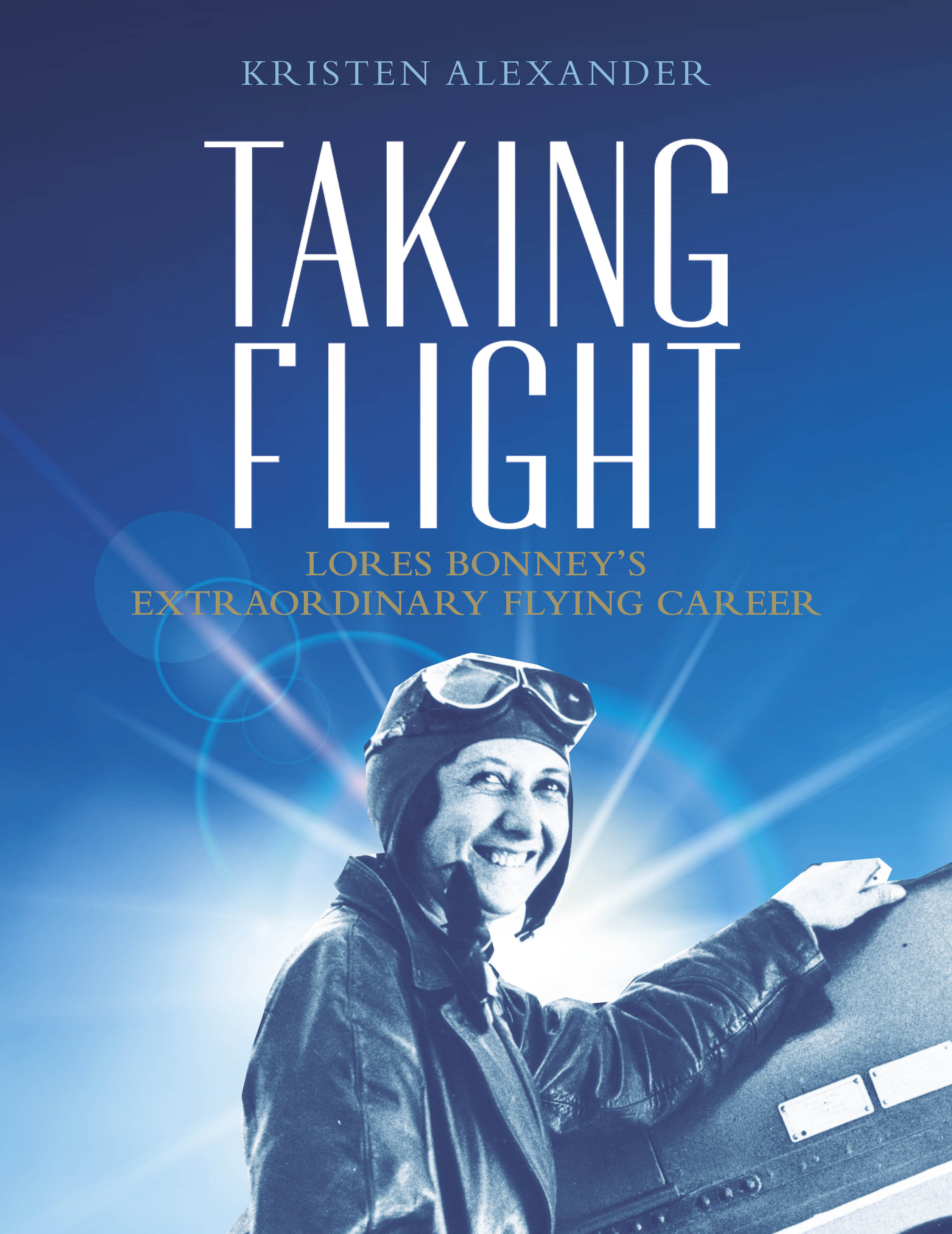 Taking Flight Lores Bonney's Extraordinary Flying Career
Taking Flight Lores Bonney's Extraordinary Flying Career
